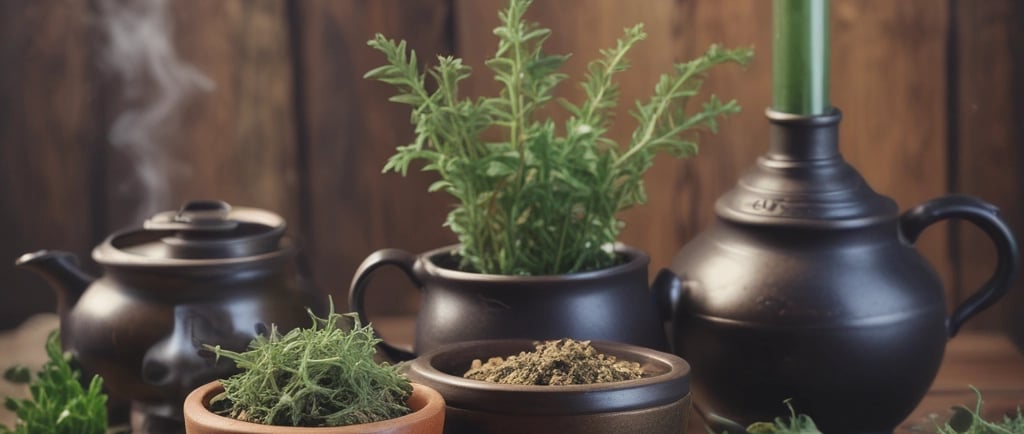Unlocking the Power of Diaphoretic Herbs: Your Natural Ally Against Fevers and More blog post
Have you ever felt that familiar chill of a fever creeping in, or watched a loved one battle a cold that just won't quit? In a world filled with over-the-counter remedies, there's something profoundly empowering about turning to nature's pharmacy. Diaphoretic herbs
10/23/20257 min read


# Unlocking the Power of Diaphoretic Herbs: Your Natural Ally Against Fevers and More
Have you ever felt that familiar chill of a fever creeping in, or watched a loved one battle a cold that just won't quit? In a world filled with over-the-counter remedies, there's something profoundly empowering about turning to nature's pharmacy. Diaphoretic herbs—those unsung heroes that promote sweating—hold a special place in herbal medicine. They're not just old wives' tales; they're time-tested tools that can help your body detoxify, regulate temperature, and support overall wellness. Whether you're a parent seeking gentle options for your kids or an adult looking to build a resilient home remedy kit, understanding these herbs could be a game-changer. Let's dive in and explore why diaphoretic herbs deserve a spot in your life, backed by science and practical wisdom.
## What Are Diaphoretic Herbs?
Diaphoretic herbs are plants that encourage perspiration, helping the body release heat and toxins through the skin. The term "diaphoretic" comes from the Greek word for "carrying through," reflecting how these herbs facilitate the expulsion of impurities. They're often categorized into two types: stimulating (warming) diaphoretics like ginger and cayenne, which boost circulation and are ideal for cold, sluggish fevers; and relaxing (cooling) diaphoretics like peppermint and elderflower, which soothe and open pores without overheating the system. This sweating action mimics the body's natural fever response, aiding in the fight against infections.
## How Diaphoretic Herbs Work in Adults and Children
In adults, diaphoretic herbs work by dilating blood vessels near the skin's surface, increasing peripheral circulation, and stimulating sweat glands to release moisture. This process cools the body internally while expelling pathogens and metabolic waste. For instance, during a fever, these herbs support the immune system's efforts to "burn out" invaders, reducing symptom duration.
In children, the mechanism is similar but requires gentler application due to their developing systems. Children's skin is more permeable, so diaphoretics can help manage mild fevers from colds or teething without suppressing the body's natural defenses. However, always start with lower doses and monitor closely, as kids metabolize herbs differently.
Scientific studies support these effects. A 2020 review in the International Journal of Environmental Research and Public Health highlighted sweating's role in detoxification, noting diaphoretic herbs like those in traditional Persian medicine promote pore opening for toxin elimination. Another 2022 study in Frontiers in Pharmacology examined gut fungi responses to diaphoretic herbs, showing they enhance sweating and heat-clearing by modulating microbiome activity, providing evidence for their antipyretic effects. For children, a 2000 Pediatrics in Review article discussed safe herbal use, emphasizing diaphoretics like chamomile for fever relief, with cautions on dosing.
## The Importance of Diaphoretic Herbs in Your Herbal Home Remedy Arsenal
Imagine having a toolkit at home that empowers you to address fevers, colds, and detox needs naturally, reducing reliance on synthetic drugs that might come with side effects. Diaphoretic herbs are essential because they align with the body's innate healing processes—promoting sweat to eliminate waste, normalize temperature, and bolster immunity. In herbal medicine, they're prized for relieving fevers by opening pores and dispelling chills, making them invaluable during seasonal illnesses.
Proper use is key: Always prepare them as hot teas for maximum effect, as heat enhances their diaphoretic action. Why? Because suppressing fevers with pharmaceuticals can prolong illness, whereas diaphoretics support the fever's purpose—fighting infection—while providing comfort. For families, they're a safe, cost-effective way to teach self-care, but consult a healthcare provider, especially for children or if pregnant. Stocking these herbs means preparedness: A simple infusion can turn a rough day into recovery mode, fostering resilience and connection to nature.
## Top 12 Diaphoretic Herbs: Descriptions, Usage, and Dosing
Here's a curated list of the top 12 diaphoretic herbs, selected for their efficacy, availability, and versatility. Each includes a detailed description, how to take it, and dosing for adults and children (based on general guidelines; adjust using Young's Rule: child's dose = adult dose × [child's age / (child's age + 12)] or consult a professional). Start low, especially for kids, and discontinue if adverse reactions occur.
1. Yarrow (Achillea millefolium): A warming diaphoretic that opens pores and reduces fever by promoting sweat. Ideal for colds with chills; anti-inflammatory and antimicrobial. Take as hot tea. Adult dose: 1-2 tsp dried flowers/leaves per cup water, 3x/day. Child (6-12 yrs): 1/2-1 tsp, 2-3x/day.
2. Elderflower (Sambucus nigra): Relaxing diaphoretic that soothes fevers and supports respiratory health. Rich in antioxidants; helps with sinus issues. Infuse in hot water. Adult: 2-3 tsp dried flowers per cup, 3x/day. Child: 1 tsp, 2x/day (avoid raw berries).
3. Peppermint (Mentha piperita): Cooling diaphoretic that relaxes muscles and eases digestion while inducing sweat. Great for headaches with fever. As tea or tincture. Adult: 1-2 tsp leaves per cup, unlimited. Child: 1/2 tsp, 2-3x/day.
4. Ginger (Zingiber officinale): Stimulating warmer that boosts circulation and fights nausea. Effective for cold fevers. Fresh root tea. Adult: 1-2g fresh root, 3x/day. Child: 0.5g, 2x/day.
5. Boneset (Eupatorium perfoliatum): Potent for flu-like aches; relaxes and promotes deep sweating. Bitter, so mix with honey. Hot infusion. Adult: 1 tsp herb per cup, 3x/day. Child: 1/4-1/2 tsp, 1-2x/day (not for under 6).
6. Cayenne (Capsicum annuum): Hot stimulant that dilates vessels for rapid sweating. Use sparingly for circulation boost. In tea or capsules. Adult: 0.25-0.5g powder, 2x/day. Child: Minimal, 0.1g in food, consult doc.
7. Angelica (Angelica archangelica): Warming root that aids digestion and sweating. Caution for blood sugar issues. Decoction. Adult: 1-2g root, 2x/day. Child: 0.5g, 1x/day.
8. Sage (Salvia officinalis): Antimicrobial cooler that reduces hot flashes and fevers. Gargle or tea. Adult: 1 tsp leaves per cup, 2-3x/day. Child: 1/2 tsp, 1-2x/day (not long-term).
9. Linden (Tilia spp.): Gentle relaxant for nervous fevers; calms anxiety. Flower tea. Adult: 1-2 tsp flowers per cup, 3x/day. Child: 1 tsp, 2x/day.
10. Catnip (Nepeta cataria): Mild for kids; relaxes and induces sweat for teething fevers. Tea. Adult: 2 tsp herb per cup, 3x/day. Child: 1 tsp, 2-3x/day.
11. Hyssop (Hyssopus officinalis): Expectorant diaphoretic for coughs with fever. Infusion. Adult: 1 tsp herb per cup, 2x/day. Child: 1/2 tsp, 1x/day.
12. Thyme (Thymus vulgaris): Antiseptic warmer for respiratory infections. Tea or steam. Adult: 1-2 tsp leaves per cup, 3x/day. Child: 0.5-1 tsp, 2x/day.
## Recipes for Diaphoretic Herbs
This section offers 3 practical recipes per herb, focusing on teas, infusions, and simple preparations. Use organic herbs; steep covered to retain volatiles. These enhance the herbs' effects and make them enjoyable.
### Yarrow
1. Basic Yarrow Tea: Steep 1 tsp dried yarrow in 1 cup boiling water for 10 min. Strain, add honey. For fever relief.
2. Yarrow-Elderflower Infusion: Mix 1 tsp each yarrow and elderflower in 2 cups hot water, steep 15 min. Sip warm for colds.
3. Yarrow Tincture: Soak 1 part dried yarrow in 2 parts vodka for 4 weeks. Strain; 20-30 drops in water, 3x/day.
### Elderflower
1. Elderflower Cordial: Simmer 2 tbsp flowers in 1 cup water with lemon zest, strain, sweeten. Dilute for drink.
2. Elderflower-Peppermint Tea: 1 tsp each in 1 cup boiling water, steep 10 min. For sinus fever.
3. Elderflower Syrup: Boil 3 tbsp flowers in 2 cups water with sugar; reduce. 1 tbsp in hot water as needed.
### Peppermint
1. Simple Peppermint Infusion: Steep 1 tsp leaves in 1 cup hot water, 5 min. For cooling sweat.
2. Peppermint-Ginger Blend: 1 tsp peppermint + 0.5 tsp ginger in 1 cup water, steep 10 min. Warms and cools.
3. Peppermint Bath: Infuse 2 tbsp in bathwater; soak for diaphoretic effect via skin.
### Ginger
1. Fresh Ginger Tea: Grate 1 tsp root, steep in 1 cup boiling water 10 min. Add lemon.
2. Ginger-Cayenne Shot: Mix 1 tsp ginger juice + pinch cayenne in warm water. For quick circulation boost.
3. Ginger Infused Honey: Steep sliced ginger in honey; 1 tsp in hot water as tea base.
### Boneset
1. Boneset Fever Tea: Steep 1 tsp herb in 1 cup hot water 15 min. Bitter; sweeten heavily.
2. Boneset-Yarrow Combo: Equal parts in 2 cups water, simmer 10 min. For aches.
3. Boneset Tincture in Tea: Add 10-20 drops tincture to hot water; sip for flu.
### Cayenne
1. Cayenne Warming Tea: Pinch powder in 1 cup hot water with lemon. Stir well.
2. Cayenne-Ginger Infusion: 0.25 tsp cayenne + 1 tsp ginger in 1 cup water, steep.
3. Cayenne Honey Mix: Blend pinch cayenne in honey; dissolve in hot tea.
### Angelica
1. Angelica Root Decoction: Simmer 1 tsp root in 1 cup water 20 min. Strain.
2. Angelica-Yarrow Tea: 0.5 tsp each, steep 15 min. For warming sweat.
3. Angelica Tincture: 20 drops in hot water, 2x/day.
### Sage
1. Sage Gargle Tea: Steep 1 tsp in 1 cup hot water; gargle or sip.
2. Sage-Peppermint Blend: Equal parts, infuse 10 min. For hot flashes.
3. Sage Infused Oil: Use in bath for external diaphoretic.
### Linden
1. Linden Flower Tea: 1 tsp in 1 cup hot water, steep 10 min. Calming.
2. Linden-Elderflower Mix: 1 tsp each, infuse for fever with anxiety.
3. Linden Syrup: Simmer flowers in water, add sugar; dilute in tea.
### Catnip
1. Catnip Mild Tea: Steep 1 tsp in 1 cup water 5 min. Kid-friendly.
2. Catnip-Lemon Balm Blend: Equal parts, for relaxing sweat.
3. Catnip Tincture: 10-15 drops in warm water.
### Hyssop
1. Hyssop Cough Tea: 1 tsp in 1 cup hot water, steep 10 min.
2. Hyssop-Thyme Infusion: 0.5 tsp each, for respiratory support.
3. Hyssop Steam: Add to boiling water, inhale vapors.
### Thyme
1. Thyme Antiseptic Tea: Steep 1 tsp in 1 cup water 10 min.
2. Thyme-Ginger Combo: Mix for warming effect.
3. Thyme Bath Infusion: 2 tbsp in bathwater for skin sweating.
## Summary and Conclusion
In essence, diaphoretic herbs are nature's way of helping your body sweat out the bad stuff—promoting detoxification, fever relief, and immune support through enhanced circulation and pore opening. We've covered their definitions, mechanisms (with studies showing microbiome and sweat gland effects), importance in home remedies for empowerment and natural healing, a top 12 list with detailed usage and dosing, and creative recipes to make them part of your routine.
Remember, these herbs aren't a cure-all; they're supportive allies. Always source quality herbs, start with small doses (especially for children using rules like Young's), and seek professional advice for ongoing issues. By incorporating them wisely, you'll not only comprehend their value but feel equipped to handle wellness challenges holistically. Stay curious, stay healthy—your body will thank you!
